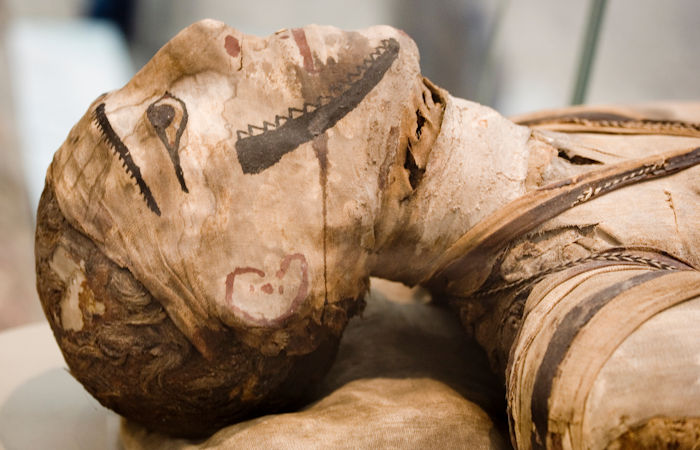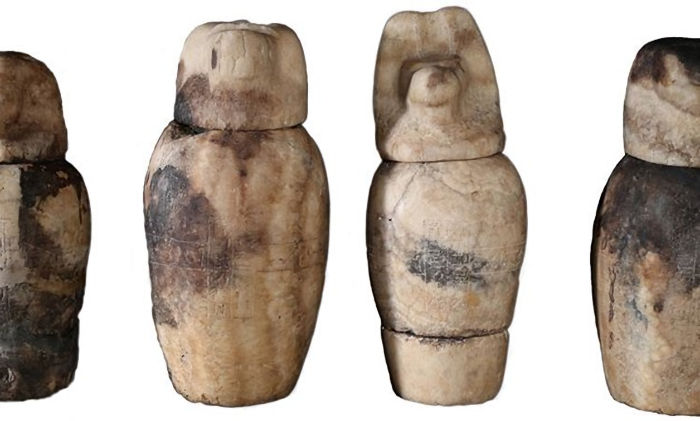Conny Waters – AncientPAges.com – Archaeologists excavating in Egypt are used to finding ancient mummies, but this discovery is different. An odd, half-mummy unearthed in the necropolis in the Al-Asasif area in Luxor has confused scientists. The half-mummy was found in the tomb of Karabasken (TT 391) where scientists also came across four canopic jars dating to the 26th Dynasty previously.

Credit: Adobe Stock – markrhiggins
The baffling half-mummy was discovered some years ago and it has now been reported the ancient remains await to be investigated by experts.
According to a report published by Al-Sharq al-Awsat newspaper, on May 23, the US mission operating in the Al-Asasif area discovered inside the cemetery a mummy consisting of only the upper half of the body of a young man truncated at the waist.
The newspaper quoted the mission as saying that all the cemetery’s contents were damaged due to frequent floods. Three coffins were found, including the truncated half-man mummy. The expedition plans to announce the results of its study in January 2024.
The US-Egyptian mission has been working at the site since 2006. So far, scientists have managed to clear, restore, and reconstruct the tombs of Karabasken (TT 391), Karakhamun (TT 223), and Irtieru (TT 390), on the West Bank of Luxor. The science team has also found thousands of fragments of the collapsed decoration of the tombs and reconstructed the second pillared hall and part of the first pillared hall in the Karakhamun necropolis.
“The tombs and cemeteries of the Al-Asasif area are known for their beautiful surprises and their magnificent inscriptions that can compete with the Valley of the Kings and Queens,” Bᴀssam al-Shammaa, a researcher in Egyptology, told Al-Monitor.
The Egyptian Ministry of Tourism and Antiquities states the tombs are from the 18th, 25th, and 26th dynasties, covering the period from 1550 to 525 B.C. but officials are cautious and unwilling to speculate about the unearthed half-mummy.
According to Al-Monitor tried to obtain more information about this perplexing archaeological discovery “
The half-mummy might have been violated and looted by thieves, Shammaa explained. The second possibility is “that the man was eaten by a hippopotamus, crocodile or lion during a hunting trip. Numerous accidents of this kind occurred in ancient Egypt, according to Pharaonic literature.”
The third scenario, he said, could be that the lower part of the body was lost in battle, but he thinks the wild-animal explanation is most likely. He urged the US team of the mission, headed by researcher Elena Pischikova, to quickly release the results of the study, “especially since it was discovered eight years ago.”

Four canopic jars from the 26th Dynasty, dedicated to “the lady of the house Amenirdis.” Credit: Ministry of Antiquities
“This mummy is a unique case. I think the mummified man was a military man and he lost the lower part of his body in a fight or it was eaten by a lion or a hippopotamus. He was being honored by being buried in this tomb,” Hussein Abdel Basir, director of the Antiquities Museum at Bibliotheca Alexandrina, told Al-Monitor.
He also emphasized that “a specific scientific explanation requires lengthy studies, and the archaeological team is looking at the family tree of this mummy, with DNA analysis or CT scans.”
It has happened in the past that scientists have discovered partly destroyed ancient mummies. One such case was described earlier here on AncientPages and relates to the mysterious Egyptian tomb 10A where someone committed a crime 4,000 years ago and it’s still unknown what happened inside the burial.
See also: More Archaeology News
Egyptian mummies have on several occasions been stolen or destroyed. Reconstructing the events from the distant past is challenging to modern science but there is still hope to learn about the idenтιтy of the half-mummy found in the tomb of Karabasken (TT 391).
Written by Conny Waters – AncientPages.com Staff Writer





